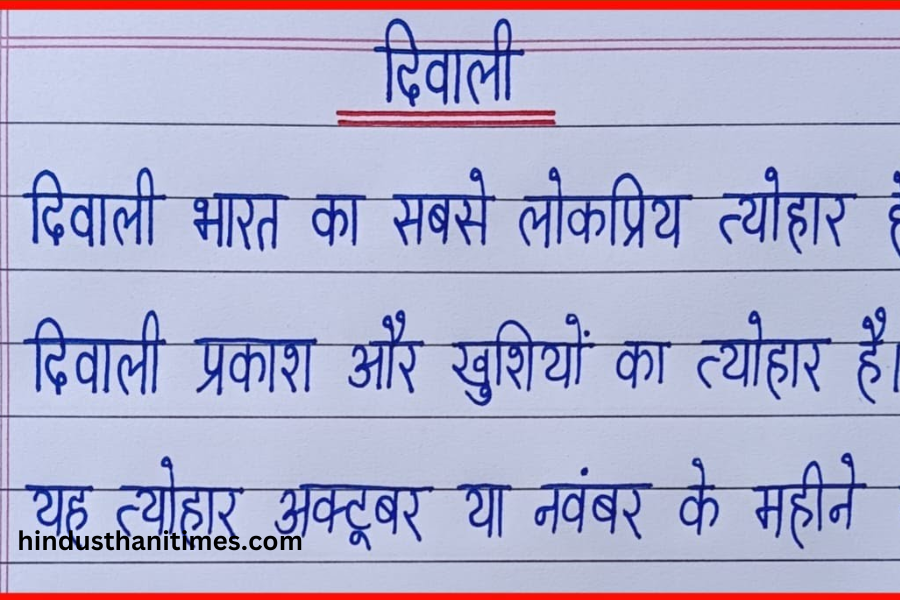Diwali, also known as Deepavali, is one of the most widely celebrated festivals in India. It is a festival of lights that signifies the victory of light over darkness and good over evil. The festival brings joy, happiness, and a sense of togetherness among people. In this essay, we will explore the significance of Diwali in Indian culture, its traditions and rituals, decorations and preparations, sweets and delicacies, gifts and exchanges, fireworks and celebrations, and how Diwali is celebrated in different regions of India. We will also discuss the importance and benefits of writing a Diwali essay in Hindi for a child and provide some tips for writing an engaging essay.
Introduction to Diwali
Diwali, derived from the Sanskrit word “Deepavali,” means a row of lights. It is celebrated on the darkest night of the Hindu lunar month of Kartik. The festival usually falls between October and November, depending on the Hindu calendar.
Diwali marks the return of Lord Rama, along with his wife Sita and brother Lakshmana, from their 14-year exile and the victory over the demon king Ravana. People light oil lamps called “diyas” to welcome Lord Rama and to symbolize the triumph of light over darkness.
Diwali is not only celebrated by Hindus but also by Sikhs, Jains, and Buddhists, each with their own significance and traditions.
Significance of Diwali in Indian Culture
Diwali holds immense cultural and religious significance in India. It is a time for families to come together and celebrate the victory of good over evil. The festival represents the triumph of righteousness, knowledge, and prosperity.
It is believed that Goddess Lakshmi, the goddess of wealth and prosperity, visits every household during Diwali and blesses them with abundance. People clean and decorate their homes to welcome the goddess and light lamps to guide her way. Diwali is also a time for self-reflection and spiritual growth. It is a time to let go of negativity, forgive others, and start afresh.
Diwali Traditions and Rituals
Diwali is a festival filled with traditions and rituals that have been passed down through generations. One of the most important rituals is the lighting of diyas and candles. People decorate their homes with colorful rangoli patterns made of colored powders and flowers.
They also adorn their doorways with garlands made of marigold flowers and mango leaves. Another significant tradition is the worship of Goddess Lakshmi and Lord Ganesha.
Families gather for puja (prayer) and offer prayers, sweets, and fruits to the deities. Firecrackers are also a part of Diwali celebrations, although there is a growing awareness about the harmful effects of noise and air pollution caused by fireworks.
Diwali Decorations and Preparations
In the weeks leading up to Diwali, people start preparing for the festival by cleaning their homes and getting rid of clutter. This is done to welcome Goddess Lakshmi and to ensure that the house is filled with positive energy.
Once the cleaning is done, people begin decorating their homes with lights, rangoli, and flowers. The markets are filled with colorful decorations, earthen lamps, and beautiful diyas. People also buy new clothes and jewelry for themselves and their loved ones. The markets are bustling with activity as everyone prepares for the festivities and shops for gifts and sweets.
Diwali Sweets and Delicacies
Diwali is a time for indulging in delicious sweets and delicacies. Traditional sweets like laddoos, jalebis, barfis, and gulab jamuns are prepared in every household. People also exchange sweets and snacks with their friends and neighbors as a gesture of goodwill and celebration.
The aroma of freshly made sweets fills the air, and children eagerly wait to savor the mouth-watering delicacies. Diwali is also a time when people experiment with new recipes and try their hand at making different types of sweets and savory snacks.
Diwali Gifts and Exchanges
Exchanging gifts is an integral part of Diwali celebrations. It is a way to express love, gratitude, and appreciation towards loved ones. People exchange gifts with family members, friends, and colleagues. The gifts can range from traditional items like clothes, jewelry, and home decor to modern gadgets and accessories. The act of giving and receiving gifts brings joy and strengthens relationships. It is a time to show generosity and spread happiness among others.
Diwali Fireworks and Celebrations
Fireworks are an integral part of Diwali celebrations. Bursting firecrackers is a way to celebrate the victory of light over darkness and to drive away evil spirits. However, in recent years, there has been a growing concern about the environmental impact and the harm caused by fireworks.
Many people are now opting for eco-friendly celebrations by using noiseless and pollution-free alternatives. Community gatherings, cultural performances, and firework displays are also organized to celebrate Diwali. The night sky lights up with the vibrant colors of fireworks, creating a mesmerizing spectacle.
Diwali in Different Regions of India
Diwali is celebrated with great enthusiasm and fervor throughout India. However, each region has its unique way of celebrating the festival. In North India, Diwali is associated with the legend of Lord Rama and is celebrated by lighting diyas and bursting firecrackers.
In South India, Diwali coincides with the celebration of Lord Krishna’s victory over the demon Narakasura. People wake up early in the, take an oil bath, and wear new clothes. In West Bengal, Diwali is known as Kali Puja and is dedicated to Goddess Kali.
In the state of Gujarat, people celebrate Diwali with the vibrant dance form called Garba. Each region adds its own flavor and customs to the festival, making it a truly diverse and colorful celebration.
Diwali Essay in Hindi for Child – Importance and Benefits
Writing a Diwali essay in Hindi for a child has several benefits. It helps the child connect with their cultural roots, learn about the significance of the festival, and develop their language skills. Writing an essay in Hindi also enhances the child’s creativity and critical thinking abilities.
It allows them to express their thoughts and feelings about Diwali in their own words. Moreover, writing in Hindi helps in preserving and promoting the language and culture of India. It instills a sense of pride in the child and makes them feel connected to their heritage.
Tips for Writing a Diwali Essay in Hindi for Child
Writing a Diwali essay in Hindi for a child can be a fun and engaging activity. Here are some tips to make the essay writing process easier:
- Research and gather information about Diwali: Before writing the essay, gather facts, stories, and details about the festival. This will help the child create a well-informed and comprehensive essay.
- Plan the structure: Help the child organize their thoughts by creating an outline. Divide the essay into sections like introduction, significance of Diwali, traditions and rituals, decorations, sweets and delicacies, gifts and exchanges, fireworks and celebrations, and conclusion.
- Use simple and clear language: Encourage the child to use simple and clear language while writing the essay. Avoid using complex words or phrases that may confuse the reader.
- Include personal experiences: Ask the child to share their personal experiences and memories of Diwali. This will add a personal touch to the essay and make it more relatable.
- Proofread and edit: After writing the essay, help the child proofread and edit it. Check for any grammatical errors or spelling mistakes and make necessary corrections.
Conclusion
Diwali is a festival that brings joy, happiness, and unity among people. It is a time to celebrate the victory of light over darkness and to spread love and positivity. Writing a Diwali essay in Hindi for a child not only helps them understand the significance of the festival but also encourages them to embrace their culture and heritage. By writing about Diwali, children can express their thoughts, feelings, and experiences, while also developing their language and creative skills. So, let us encourage children to celebrate Diwali by writing an essay in Hindi and sharing the joy and essence of this beautiful festival.



